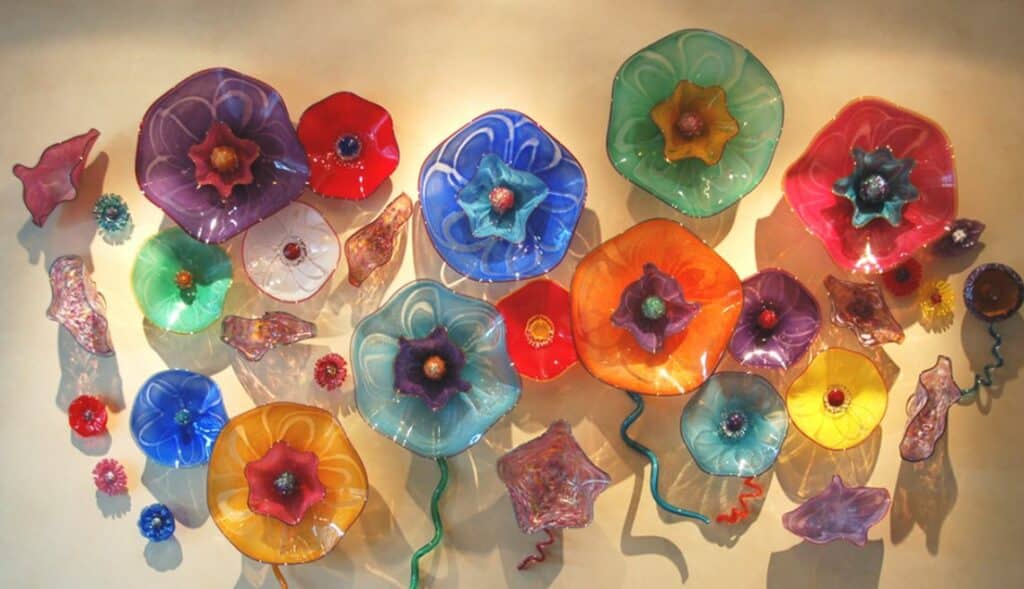“Captivating Creations: Celebrating Glass Art’s Visionaries”
In this article, we will examine ten examples of “The Beauty of Glass Art: 10 Glassblowers to Admire,” whose work not only stands as a testament to their craftsmanship but also as an expression of their creativity and ingenuity. These glassblowers’ work will blow your mind for a number of reasons. Get ready to have your mind blown by the amazing world of glass art.
If you have ever stood in awe of the ethereal, translucent beauty of glass art, then you are aware that it possesses a special ability to capture light and transform it into something that is truly enchanted. Glassblowing is an age-old craft that has developed into a dynamic and cutting-edge field.
Artists use a wide range of tools and methods to work with materials and make their ideas come to life in three dimensions. Here are some Famous Sculptors Pushing the Boundariesin three dimensions
The Different Types of Glassblowing
Glassblowing is a fascinating and intricate art form that has been practiced for centuries. Over time, it has evolved into various types and techniques, each with its own unique characteristics and applications. Here, we explore the different types of glassblowing:
- Offhand glassblowing: The most traditional method uses a blowpipe to gather molten glass from a furnace and shape it by hand. Vases, bowls, cups, and sculptures can be made by offhand glassblowing.
- Mold blowing: This glassblowing method uses a mold to shape glass. After heating the mold, molten glass is blown in. After the glass cools, the mold is removed to reveal the finished object. Glass bottles and jars are mass-produced using mold blowing.
- Flameworking: A small torch or lamp melts glass rods and tubes in flameworking. Shape the molten glass by hand or with tools. Flameworking is used to make delicate beads, jewelry, and figurines.
- Pâte de verre: Using a kiln, pâte de verre glassblowers melt broken glass or glass powder. Put molten glass in molds or shape it by hand. Sculptures and panels made of pâte de verre are colorful and decorative.
- Kilnforming: Glassblowing using a kiln to melt and shape glass. Kilnforming can make plates, bowls, vases, and sculptures.
10 Glassblowers To Admire For Pushing the Boundaries of Glass Art
Some forms of artistic expression have been around for centuries, while others are always developing in new directions and testing the limits of human ingenuity. The latter type of artwork is considered to be glass art. Glass artists are always experimenting with new approaches, styles, and forms in order to create works that are captivating and original. We are pleased to introduce you to the following ten glassblowers who are at the forefront of pushing the envelope in terms of glass art:
1. Dale Chihuly

Chihuly is one of the most well-known glass artists in the world, and his work is renowned for its large scale, vivid colors, and intricate forms. Chihuly is also one of the most successful glass artists in the world. He has expanded the capabilities of glassblowing by producing works of art that are remarkable in terms of their technical accomplishments as well as their aesthetic appeal.
Key Profile: Dale Chihuly
| Aspects | Description |
| Birthdate: | September 20, 1941 |
| Nationality: | American |
| Artistic Style: | Studio glass |
| Influence: | Pilchuck Glass School, Harvey Littleton, Venetian glassmaking |
| Notable Works: | Chandeliers, baskets, and boats |
| Innovations: | Large-scale works, bold colors, complex forms |
| Legacy: | Inspiration for a new generation of glass artists |
2. Kim Lewis

Lewis is a glass artist who specializes in the creation of large-scale sculptures that frequently incorporate materials that have been recycled. The natural world serves as a primary source of inspiration for her work, which frequently delves into topics such as environmentalism and sustainable living.
Key Profile: Kim Lewis
| Aspects | Description |
| Birthdate: | 1950 |
| Nationality: | American |
| Artistic Style: | Studio glass |
| Influence: | Nature, environmentalism, sustainability |
| Notable Works: | Large-scale sculptures incorporating recycled materials |
| Innovations: | Use of recycled materials, exploration of environmental themes |
| Legacy: | Model for sustainable glassmaking practices |
3. Kevin Perkins

Glass artist Perkins is responsible for the creation of intricate and delicate sculptures that are frequently influenced by the forms of plants. Both the accuracy and the use of color in his work have earned him a reputation for excellence.
Key Profile: Kevin Perkins
| Aspects | Description |
| Birthdate: | 1961 |
| Nationality: | American |
| Artistic Style: | Studio glass |
| Influence: | Botanical forms, precision, color |
| Notable Works: | Pilchuck Glass School, Bertil Vallien |
| Innovations: | Intricate and delicate sculptures inspired by botanical forms |
| Legacy: | Use of color, precision, and botanical forms |
4. Kosta Boda

Since 1742, the Swedish glassworks known as Kosta Boda has been turning out glass of the highest possible quality. The company has earned a reputation in the industry for the cutting-edge designs it produces and the superior materials it uses.
Key Profile: Kosta Boda
| Aspects | Description |
| Birthdate: | 1742 |
| Nationality: | Swedish |
| Artistic Style: | Studio glass |
| Influence: | Traditional Swedish glassmaking, contemporary design |
| Notable Works: | Crystal, glass sculptures, tableware |
| Innovations: | Innovative designs, use of high-quality materials |
| Legacy: | Inspiration for contemporary glassmaking design |
5. Venini

Venini is an Italian glassworks that has been around since 1921 when it was established. The company has built a name for itself thanks to the vibrant and expressive glasswork that it creates, which is frequently influenced by the classic design motifs of Venice.
Key Profile: Venini
| Aspects | Description |
| Birthdate: | 1921 |
| Nationality: | Italian |
| Artistic Style: | Studio glass |
| Influence: | Traditional Venetian glassmaking, contemporary art |
| Notable Works: | Murano glassmaking techniques, contemporary art movements |
| Innovations: | Colorful and expressive glasswork |
| Legacy: | Preservation of Venetian glassmaking traditions, inspiration for contemporary glass artists |
6. Berengo Studio

The Venetian glassworks known as Berengo Studio dates back to its founding in 1966. The glasswork produced by this company is renowned for its superior quality and is frequently influenced by the time-honored methods of Murano glassmaking.
Key Profile: Berengo Studio
| Aspects | Description |
| Birthdate: | 1966 |
| Nationality: | Italian |
| Artistic Style: | Studio glass |
| Influence: | Traditional Murano glassmaking techniques, contemporary design |
| Notable Works: | Murano glassmaking techniques, contemporary design movements |
| Innovations: | High-quality glasswork inspired by traditional Murano techniques |
| Legacy: | Inspiration for contemporary glass artists working in the Murano tradition |
7. Lasvit

Lasvit is a glassworks that was established in the Czech Republic in 2007. The company is well-known for the modern glass designs that it produces; these designs are frequently utilized in construction and interior design projects.
Key Profile: Lasvit
| Aspects | Description |
| Birthdate: | 2007 |
| Nationality: | Czech |
| Artistic Style: | Studio glass |
| Influence: | Contemporary design, architecture, interior design |
| Notable Works: | Contemporary design movements, architectural and interior design trends |
| Innovations: | Contemporary glass designs for architectural and interior design projects |
| Legacy: | Inspiration for contemporary glass artists working in architecture and interior design |
8. Dan Flavin

The light installations that Flavin created in the United States with neon tubes are what brought him the most fame as a minimalist artist. In addition to that, he produced a number of works utilizing stained glass and fluorescent lighting.
Key Profile: Dan Flavin
| Aspects | Description |
| Birthdate: | April 1, 1933 |
| Nationality: | American |
| Artistic Style: | Minimalism, light art |
| Influence: | Minimalism, neon light art |
| Notable Works: | Light installations made with neon tubes |
| Innovations: | Use of neon tubes in fine art, exploration of light as a medium |
| Legacy: | Inspiration for contemporary light artists |
9. Jeff Koons

Koons is a contemporary artist working in the United States who is best known for his Pop Art sculptures. He is responsible for a number of works, including the well-known “Rabbit” sculpture, which he created using glass.
Key Profile: Jeff Koons
| Aspects | Description |
| Birthdate: | January 21, 1955 |
| Nationality: | American |
| Artistic Style: | Pop Art |
| Influence: | Pop Art, advertising, consumerism |
| Notable Works: | Balloon Dog, Rabbit |
| Innovations: | Use of glass in Pop Art sculptures, exploration of consumerism and kitsch |
| Legacy: | Inspiration for contemporary artists working with glass in a Pop Art style |
10. Shiro Kuramata

Kuramata was a Japanese architect and designer who was well-known for creating designs that were cutting-edge and ahead of their time. He worked with glass to create a number of works, one of which was the well-known “Miss Blanche” chair.
Key Profile: Shiro Kuramata
| Aspects | Description |
| Birthdate: | February 29, 1934 |
| Nationality: | Japanese |
| Artistic Style: | Contemporary design, architecture |
| Influence: | Japanese design, postmodernism |
| Notable Works: | Miss Blanche chair, Glass House |
| Innovations: | Innovative use of glass in furniture and architecture, exploration of the relationship between glass and space |
| Legacy: | Inspiration for contemporary designers and architects working with glass |
Glass art is a medium that lets artists be very creative and express themselves in many ways. What the artists above have to offer is just a small taste of the huge and varied world of glassblowing. Each artist’s unique vision adds to the field of glass art, from Dale Chihuly’s intricate blown glass to Shelley James’s cutting edge work. People are still drawn to the beauty and allure of glass art, and with artists like these, the future of this very old craft looks very bright.
FAQ
What exactly is glassblowing?
Glassblowing is an ancient art form that involves using a blowpipe and various tools to shape molten glass into various objects or sculptures. It is an ancient technique that has been used by artisans and artists since the Roman Empire.
Where can I see live glass art?
You can find glass art in museums, art galleries, and even public spaces. The Corning Museum of Glass in New York, the Museum of Glass in Tacoma, Washington, and various art galleries around the world are some notable places to see glass art.
Can I learn to blow glass on my own?
Yes, many studios and institutions offer beginner glassblowing classes and workshops. It’s a difficult but rewarding art form, and with practice, you can make your own stunning glass pieces.





